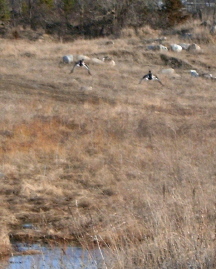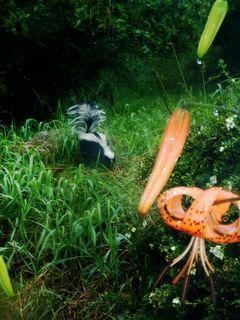Well, of course, it turns out that several species of duck do perch in trees, in particular the wood duck, which these turned out to be. Wood ducks nest in cavities in trees, sometimes far from water. And after the ducklings hatch (precocial, as all ducks are, meaning they come out of the shell ready to go), they jump from the tree and are lead by their mother overland to water, where they live (unless eaten) until they are able to fly.
I saw that particular pair of ducks several times over last spring, but did not discover if or where they nested.
This morning I set out for a walk, striding up the hill to the field, and startled a pair of wood ducks that were perched in a tree in the neighbour's backyard. I didn't get much of a look, but I caught up with them again in the swamp in the cedar bush. Perhaps they'll nest there this year.
In the scrape there is a low spot that is a small pond for at least a month or two in the spring. The night before last, its banks were the dancing ground for a woodcock, but this morning, as it is many spring mornings, it was a resting and meeting place for mallards. The picture below shows (not terribly distinctly) two mallard drakes leaving the pond as I came up.

Brothers in Flight





